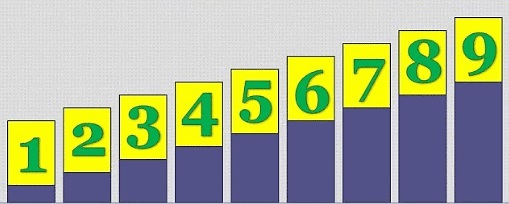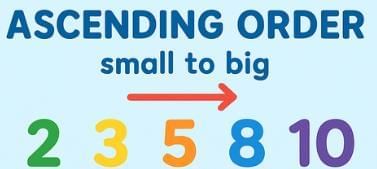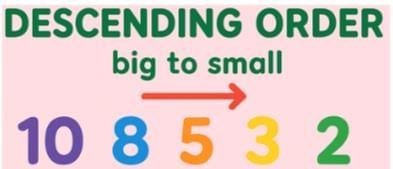Ascending Order & Descending Order | Maths for UKG PDF Download
Hello, little friends! Today, we will learn two fun ways to put numbers in order: Ascending Order and Descending Order.
What is Ascending Order?
- Ascending means small to big.
- We start with the smallest number and go up to the biggest number.
Think about this:
You have 5 friends standing in a line. You arrange them from the shortest to the tallest. That’s ascending order!

If we talk in numbers, 
Steps:
- Look at all your numbers.
- Find the smallest number.
- Write it first.
- Find the next smallest number.
- Keep going until all numbers are in order.
Example:
Numbers: 8, 2, 5, 10, 3
More examples of small to big:
Pencil sizes range from short to long.
Cups from small to big.

What is Descending Order?
Descending means from big to small.
We start with the biggest number and go down to the smallest number.
Think about this:
You have a stack of big boxes and small boxes. You arrange them with the biggest box first and the smallest at the end. That’s descending order!

If we talk in numbers, 
Steps:
- Look at all your numbers.
- Find the biggest number.
- Write it first.
- Find the next biggest number.
- Keep going until all numbers are in order.
Example:
Numbers: 8, 2, 5, 10, 3

More examples of big to small:
- Water bottles from tall to short.
- Balls from big to tiny.

Remember:
Ascending = small to big
Descending = big to small
Next time you play with toys, books, or even fruits, try arranging them in both orders. It’s fun and helps you learn numbers too!
|
44 videos|179 docs|5 tests
|
FAQs on Ascending Order & Descending Order - Maths for UKG
| 1. What is the difference between ascending order and descending order? |  |
| 2. How can I arrange a list of items in ascending order? |  |
| 3. What are some practical uses of sorting items in ascending and descending order? |  |
| 4. Can I sort words or letters in ascending and descending order? |  |
| 5. What tools or methods can help me sort data in ascending or descending order? |  |
















